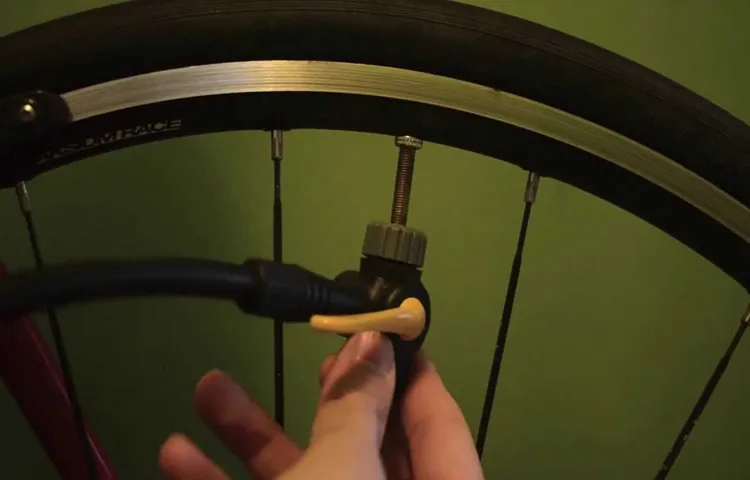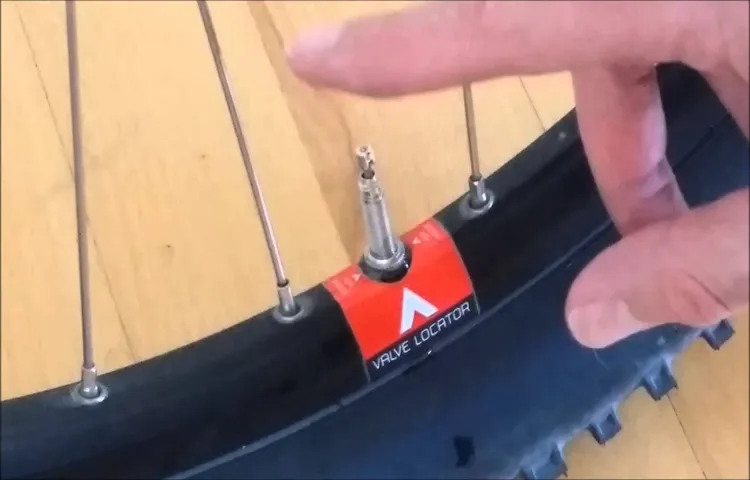Do you love cycling? Maybe you’re getting ready for a leisurely bike ride, but find that your tires need some air. If you have a Presta valve on your bike, the process for inflation can be a bit perplexing at first. But don’t worry, inflating a bike tire with a Presta valve isn’t as tricky as it may seem! Firstly, it’s important to understand that Presta valves are typically found on higher-end bicycles and are known for their narrow shape.
This means that the inflation process is slightly different than with other valves, such as Schrader valves. To inflate your Presta valve tire, you’ll need a few tools. A bike pump with a Presta valve head is necessary, as well as a pressure gauge to ensure you’re inflating to the appropriate level.
Once you have these items, you’re ready to get started! Essentially, inflating your Presta valve tire requires opening the valve before adding air. This can be done by unscrewing the valve cap and pushing it forward slightly to release the valve. From there, you can attach your pump’s Presta valve head and begin inflating.
Just make sure to check the pressure regularly and adjust as needed. Think of inflating a Presta valve tire like filling a balloon with a narrow opening. It requires a bit more finesse and patience, but once you get the hang of it, it will become second nature.
So don’t let those narrow valves intimidate you – with the right tools and a little know-how, you’ll be back on your bike in no time!
Table of Contents
What is a Presta Valve?
If you’re new to cycling, the Presta valve may seem a bit daunting. But fear not, it’s actually quite simple to air up a bike tire with a Presta valve. Let’s start with the basics: a Presta valve is a type of valve commonly found on high-end bicycles.
Unlike a Schrader valve (the type found on car tires), Presta valves are thinner and feature a screwable cap. To air up a tire with a Presta valve, first ensure that the cap is unscrewed and the lock nut on the valve stem is loosened. Next, attach the chuck of your pump to the valve and pump away! About halfway through, you’ll likely hear a hiss as air escapes.
Don’t worry, this is just the valve adjusting itself and is completely normal. Once you’ve reached the desired pressure, remove the chuck and tighten the lock nut to prevent air from escaping. And there you have it – a properly inflated bike tire with a Presta valve!
Description of Presta Valve
A Presta valve is a type of valve used for bike tires, that is known for its narrow and elongated shape, which makes it distinguishable from other types of valves. It is also referred to as a French valve or high-pressure valve. Unlike a Schrader valve, which is commonly found in car tires, the Presta valve has a smaller diameter and requires a separate attachment for inflation.
This valve is commonly used in road bikes and is ideal for racing owing to its lightweight construction and high-pressure capacity. It is usually made of brass or aluminum and has a threaded top nut, which helps to secure it to the bike rim. The Presta valve is a popular choice among cyclists, particularly those who are serious about their sport.
Overall, the Presta valve is a reliable and efficient valve that serves its purpose effectively, making it a great choice for those who take their cycling seriously.

Tools You Will Need
If you’re new to cycling, you may be wondering how to air up your bike tire with a Presta valve. The first thing you’ll need is a Presta valve adapter. This small accessory screws onto the end of your pump and allows it to fit onto the valve of your Presta tube.
Without this adapter, your pump won’t be able to create a seal on the valve. Once you have the adapter, the process is easy. Simply unscrew the valve cap on your Presta tube and press the head of your pump onto the adapter.
Pump up the tire to your desired pressure, and then unscrew the pump head and replace the valve cap. It’s important to note that Presta valves have a higher air pressure rating than Schrader valves, so you may need to pump your tire up to a higher pressure than you’re used to. However, this also means that Presta valves are better sealed and less likely to leak air over time.
Overall, learning how to air up your bike tire with a Presta valve is a simple process with the right tools. Don’t let this valve type intimidate you – it’s a straightforward process that will help keep your bike tires performing at their best.
List of Tools
When it comes to DIY projects, having the right tools is crucial for getting the job done efficiently and effectively. Whether you’re a seasoned DIYer or just starting out, there are a few tools that you’ll need to have on hand. First up is a good set of screwdrivers, including both flat-head and Phillips-head varieties.
A set of pliers, including both needle-nose and standard styles, is also important. Along with these basic hand tools, you’ll want to have a power drill with a variety of bits, a saw (circular, reciprocating, or jigsaw), and a hammer. Safety equipment, such as gloves, safety glasses, ear protection, and a dust mask, is also essential to keep you safe while you work.
With these tools in your arsenal, you’ll be ready to take on any DIY project that comes your way.
Steps to Inflate a Bike Tire with a Presta Valve
If you’re new to biking, the prospect of inflating a tire with a presta valve can be intimidating. But don’t worry, it’s easier than it looks! First, locate your valve – it will be a small, slender valve with a threaded top. Unscrew the top to reveal the valve.
Next, attach your pump nozzle to the valve – make sure it’s snug and secure. Now, it’s time to pump. Slowly pump air into the tire – you’ll feel some resistance, but that’s normal.
Keep an eye on the pressure gauge on your pump – you don’t want to overinflate your tire. Once you’ve reached the desired pressure, unscrew the nozzle from the valve, screw the top of the valve back on and you’re done! With these simple steps, you’ll be inflating tires with a presta valve like a pro in no time.
Step 1: Remove the Valve Cap
Inflating your bike tire with a Presta valve is a quick and easy task, requiring a few simple steps. The first step is to remove the valve cap, which is a small cylindrical cap located at the top of the valve. Use your fingers to unscrew the cap and set it aside.
It’s important not to lose this cap as it helps keep dirt, debris, and moisture from entering the valve and causing problems down the road. Once the cap is off, you can proceed with inflating the tire. Depending on your pump, you may need to adjust the pump head or switch to a Presta-specific pump head before continuing.
With the valve cap off and the pump set up, you’re ready to move on to step 2 and start inflating your tire to the recommended pressure level. Remember to check the pressure level regularly and adjust as needed to ensure a smooth and safe ride.
Step 2: Unscrew the Valve Nut
To inflate a bike tire with a Presta valve, you’ll need to follow a few simple steps. After finding the right pump with a Presta valve adapter, the second step is to unscrew the valve nut. Although the valve may appear stuck, with a little force, the nut should loosen up.
Keep in mind that you don’t want to remove the nut completely, just loosen it enough to pump air into the tire. A common mistake is to remove the nut entirely, which could result in losing it and having to buy a new one. Once the valve nut is loose, you’ll be able to connect the pump nozzle to the valve itself.
With everything securely in place, start pumping air into the tire and listen for any leaks. When you’ve added enough air to reach the desired pressure, disconnect the pump from the valve and tighten the nut back on. It’s important to remember that despite the added steps, Presta valves offer more control over the tire’s air pressure and can, therefore, result in smoother rides.
Step 3: Attach the Pump Nozzle
When it comes to inflating a bike tire with a Presta valve, attaching the pump nozzle is a crucial step. First, ensure that the pump you’re using is compatible with Presta valves. Next, unscrew the valve cap and press the nozzle firmly onto the valve head.
You might hear a hiss of air escaping – this is normal, and it means that the valve is receiving air. Make sure that the nozzle is firmly attached, as any air leaks will affect the tire’s inflation. Once the nozzle is secured, begin pumping air into the tire.
Monitor the tire pressure while doing so, and stop pumping once it reaches the recommended pressure level. Finally, remove the nozzle from the valve head and screw the valve cap back into place. By following these simple steps, you’ll be able to inflate your bike tire with a Presta valve in no time!
Step 4: Inflate the Tire
Inflating a bike tire with a Presta valve can be a bit daunting for beginners, but once you know the steps, it’s easy-peasy. The final step is to inflate the tire to the correct pressure. You can use a pump with a pressure gauge to achieve the desired pressure.
The preferred pressure range is usually indicated on the sidewall of the tire. Use a pressure gauge to ensure the tire is inflated to the recommended level. The pressure gauge usually has a dial that shows the tire pressure in PSI or bar.
If you’re unsure about the correct pressure, consult the tire’s manufacturer’s guidelines or the store where you purchased the tire. Overinflating the tire can cause it to burst, while underinflating it can make it susceptible to punctures, so it’s crucial to check the pressure regularly. Once you’ve inflated the tire to the proper pressure, put the valve cap back on and you’re ready to hit the road.
Remember, proper tire maintenance is crucial for a smooth, safe riding experience.
Step 5: Remove the Pump Nozzle
After inflating your bike tire with a Presta valve, the next step is removing the pump nozzle. You want to make sure that you release the air in the pump head before unscrewing it from the valve. This step will help to prevent any air loss or damage to the valve.
Once you have released the pressure, you can unscrew the pump nozzle from the valve in a counterclockwise direction. Be careful not to unscrew it too quickly, as this can cause a sudden burst of air. Instead, unscrew it slowly and gently without tilting it to the side.
Once the pump nozzle has been removed, carefully replace the valve cap, ensuring that it is tight enough to prevent any air from escaping. With these steps complete, your bike tire is now ready for a smooth ride ahead!
Step 6: Screw the Valve Nut and Replace the Valve Cap
Once you’ve filled your bike tire with air, it’s time to screw the valve nut and add the valve cap back on. The valve nut should be tightened just enough to keep the valve stem from wobbling, but not so tight that it can’t be easily loosened next time you need to inflate your tire. It’s important to replace the valve cap as it helps prevent dirt and debris from getting inside the valve and causing damage in the future.
Think of it like a little hat for your valve! Remember, if you have a Presta valve, you’ll need to unscrew the valve nut before inflating, and screw it back down before putting on the valve cap. This final step ensures that your tire is properly inflated and protected against any potential damage down the road. Happy riding!
Tips for Inflating a Presta Valve Bike Tire
If you’ve ever struggled with how to air up bike tire with presta valve, don’t worry, you’re not alone. Presta valves are common on higher-end bikes, and they can be a bit trickier to inflate than the more common Schrader valves. The first thing you’ll need is a pump with a Presta valve head.
Once you’ve got that, unscrew the valve cap and push down on the tip of the valve to open it up. Then, attach the pump head to the valve and start pumping. Keep an eye on the pressure gauge and stop when you reach the desired pressure.
When you’re done, unscrew the pump head and screw the valve cap back on. It may take a bit of practice to get the hang of inflating Presta valves, but with a bit of patience, you’ll be able to do it in no time at all.
Tip 1: Check the Tire Pressure
Presta valve bike tires are becoming increasingly popular among cyclists due to their superior performance. However, inflating them can be a bit tricky as they require a different kind of pump than your average tire. So, here are some tips for inflating a Presta valve bike tire.
Tip 1: Check the Tire Pressure Before you start inflating your bike tire, it’s important to check the current tire pressure. This will give you an idea of how much air you need to add to reach your desired tire pressure level. You can find the recommended tire pressure level for your bike on the sidewall of the tire.
To check the tire pressure, unscrew the cap on the Presta valve and press a tire pressure gauge onto the valve. The gauge will give you a reading of the tire pressure. If the pressure is too low, it’s time to inflate the tire.
Inflating a Presta valve bike tire can be a little confusing, but it’s not complicated. With these tips, you can easily inflate your tire and get back on the road. So, grab your pump and get to it!
Tip 2: Lubricate the Valve
Inflating a Presta valve bike tire can be a little tricky or intimidating for some, but with a few tips and tricks, you can handle it like a pro. One helpful tip is to lubricate the valve before inserting the pump head. A small amount of lubrication, such as silicone grease or even saliva, can make a significant difference in the ease and accuracy of inflating your tire.
The lubricant eases the friction between the pump head and the valve, preventing damage to the valve stem. Plus, it helps to create a tight seal so that no air is lost during inflation. Remember, never force the pump head onto the valve as this could cause damage or lead to a flat tire.
Try adding a drop of lubricant to your valve and feel the difference in how easily and smoothly the pump head glides onto the valve. By following this simple step, you can ensure a successful and stress-free inflation process.
Tip 3: Use a Floor Pump or Hand Pump Instead of a Compressor
One of the best tips for inflating a Presta valve bike tire is to use a floor pump or a hand pump instead of a compressor. While a compressor might seem like the easiest option, it can actually lead to over-inflating your tire and causing damage. A floor pump or hand pump gives you more control over the amount of air you are adding to the tire, as you can monitor the pressure and stop pumping once you reach your desired level.
Plus, floor pumps and hand pumps are portable and easy to bring with you on the go. So, next time you need to inflate your Presta valve bike tire, skip the compressor and opt for a more precise and reliable pumping method.
Conclusion
In conclusion, airing up a bike tire with a presta valve may seem daunting at first, but with a bit of practice and the right tools, it can be as easy as riding a bike. With these simple steps, you’ll never be caught with a flat tire again (or at least not without a way to fix it). So go ahead and pump up those tires, and remember, the only thing better than a smoothly inflated tire is an inflated ego from mastering a new skill.
“
Summary of Key Points
Inflating a Presta valve bike tire can be a bit tricky if you’ve never done it before, but with a few tips, you can easily get the hang of it. First, make sure you have a pump that is compatible with Presta valves. Secondly, unscrew the valve cap and unlock the valve by pushing down on the small metal lever at the top of the valve.
This will allow air to flow into the tire. Then, attach the pump nozzle to the valve and pump until you reach the desired pressure. It’s essential to keep an eye on the pressure gauge to avoid overinflating the tire or underinflating it.
Once you reach the desired pressure, remove the pump nozzle and re-lock the valve by pushing the metal lever back up and screwing on the valve cap. By following these simple steps, you can quickly inflate your Presta valve bike tire, and hit the road with confidence.
Closing Thoughts
Inflating a Presta valve bike tire can seem like a daunting task, especially if you’re used to the more common Schrader valves. But have no fear, with just a few simple steps, you’ll be able to inflate your Presta valve tire like a pro. First, make sure you have the correct pump that is compatible with Presta valves.
Once you’ve secured your pump, remove the valve cap and unscrew the tip of the valve to open it. Press the pump head onto the valve stem and begin to inflate the tire to the desired pressure. Don’t forget to periodically check the pressure with a gauge and adjust as needed.
When you’re finished, unscrew the pump from the valve, screw the tip back down, and replace the valve cap. By following these easy steps, you’ll be able to confidently inflate your Presta valve bike tire anytime it needs a boost!
FAQs
What is a presta valve on a bike tire?
A presta valve is a type of valve found on some bike tires, typically higher-end road bikes and mountain bikes.
How do I know if my bike tire has a presta valve?
Look at the valve stem of your bike tire. If it is long, thin, and has a nut at the top, it is likely a presta valve.
Can I use a regular air pump on a presta valve?
Yes, you can use a regular air pump on a presta valve, but you will need an adapter to fit the smaller valve diameter.
How do I attach an air pump to a presta valve?
Unscrew the top nut on the valve stem, press down on the valve to release any air inside, and attach the air pump nozzle to the valve. Pump the tire up to the desired pressure and replace the nut.
What is the recommended tire pressure for a bike tire with a presta valve?
The recommended tire pressure will be printed on the sidewall of the tire. Inflate the tire to the recommended pressure for optimal performance and safety.
How often should I check the tire pressure on my bike with a presta valve?
It is recommended to check the tire pressure before every ride, especially if you haven’t ridden your bike in a while or if you notice any signs of a flat tire.
Can I inflate a presta valve with a CO2 cartridge?
Yes, you can inflate a presta valve with a CO2 cartridge, but you will also need an adapter to fit the smaller valve diameter. Be sure to follow the instructions on the cartridge carefully.



